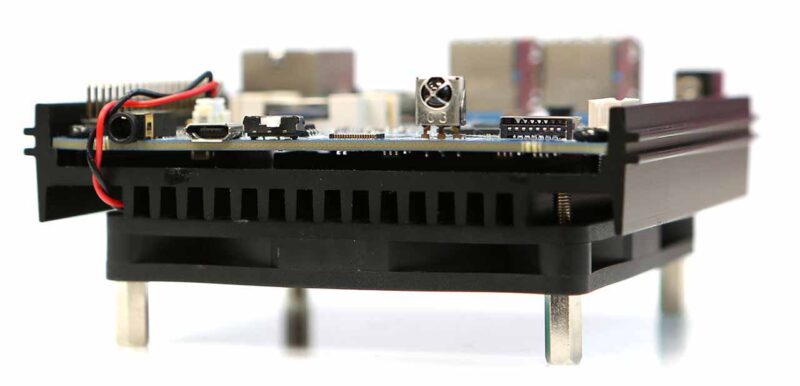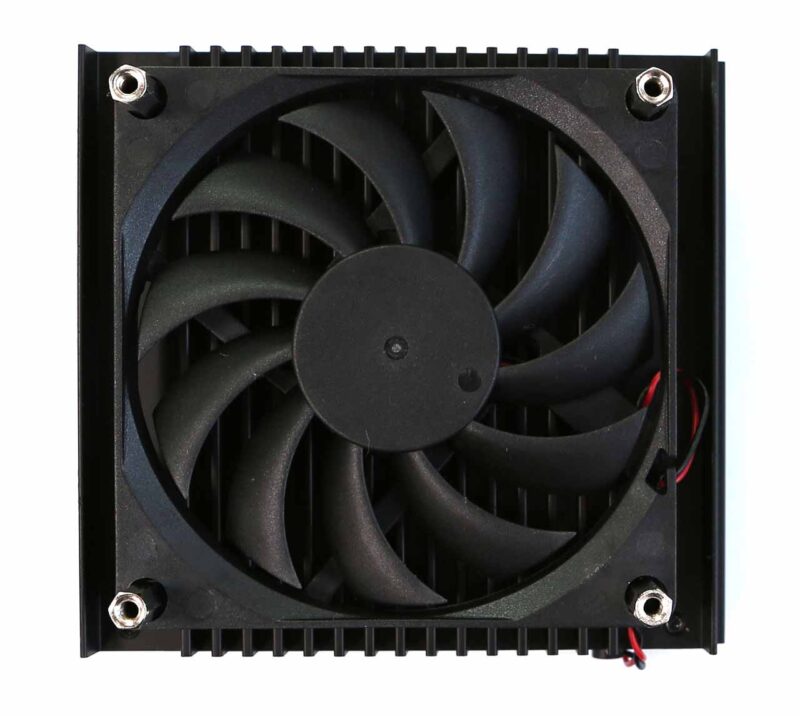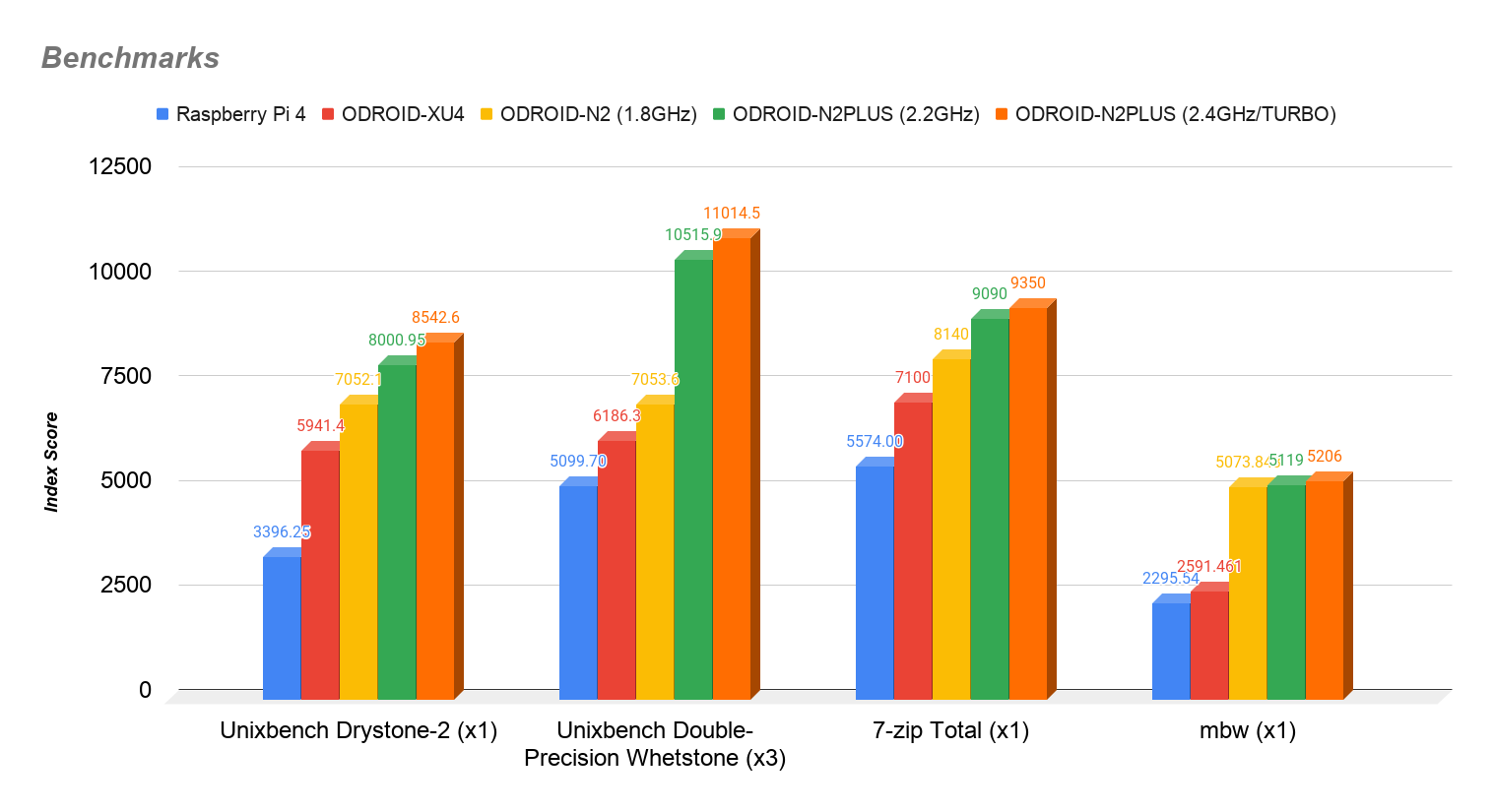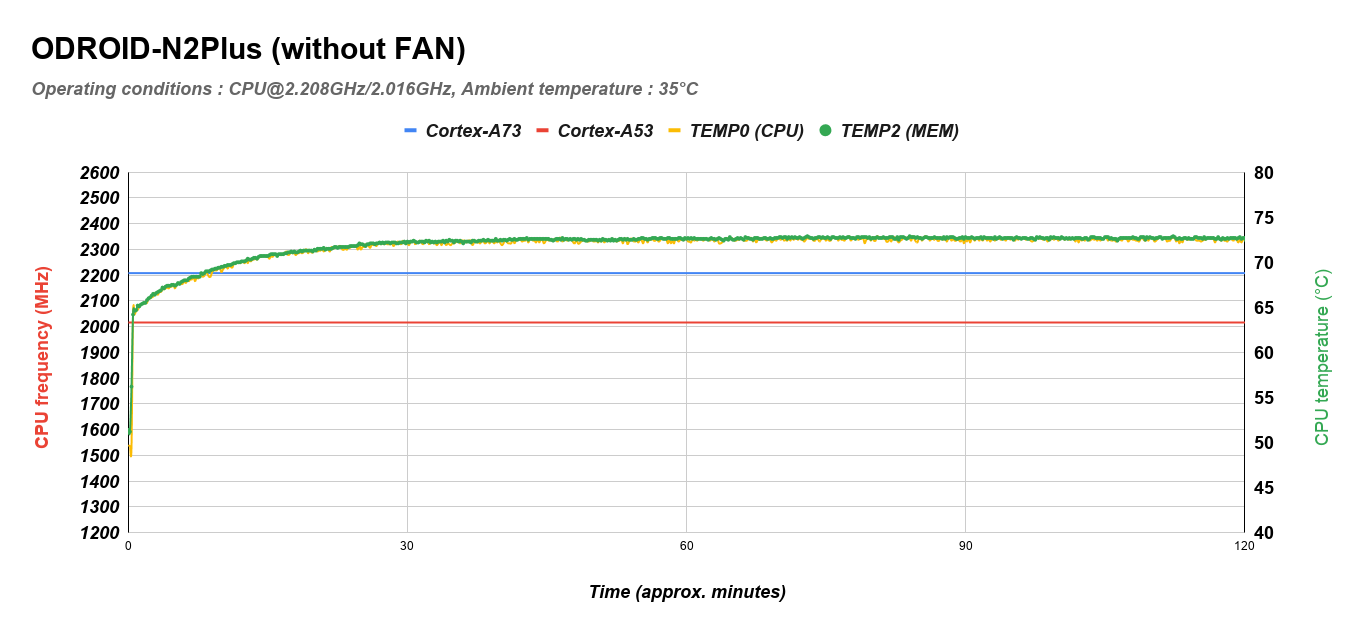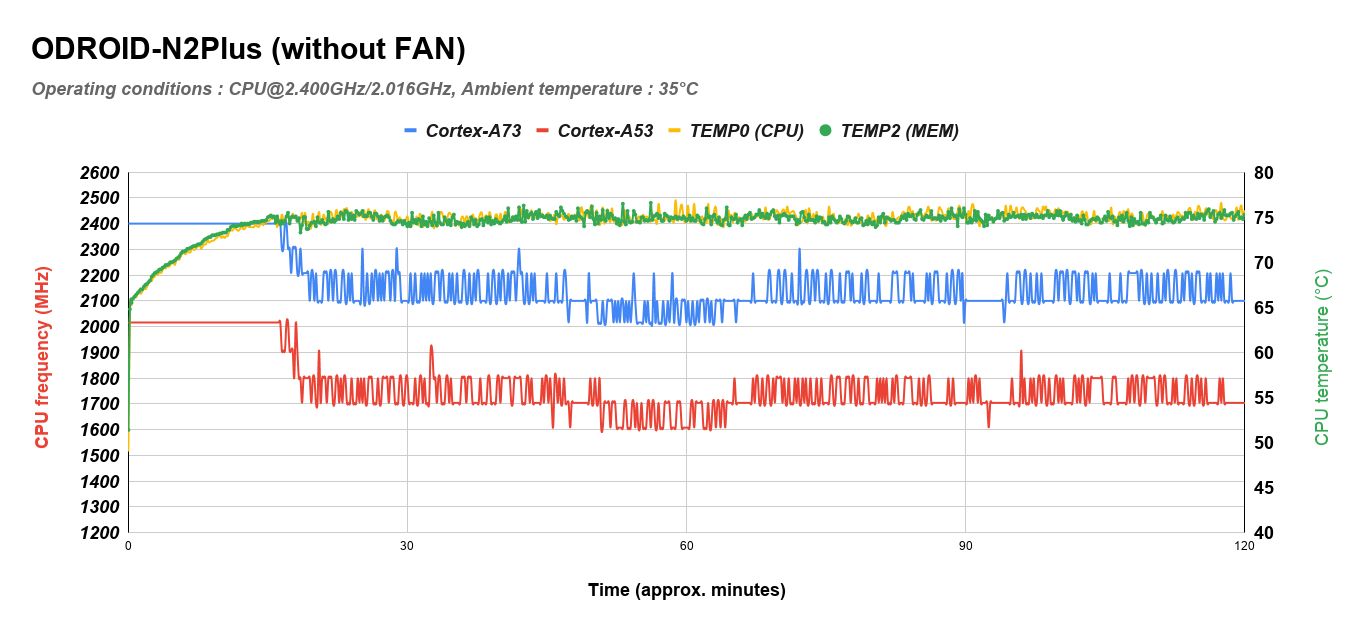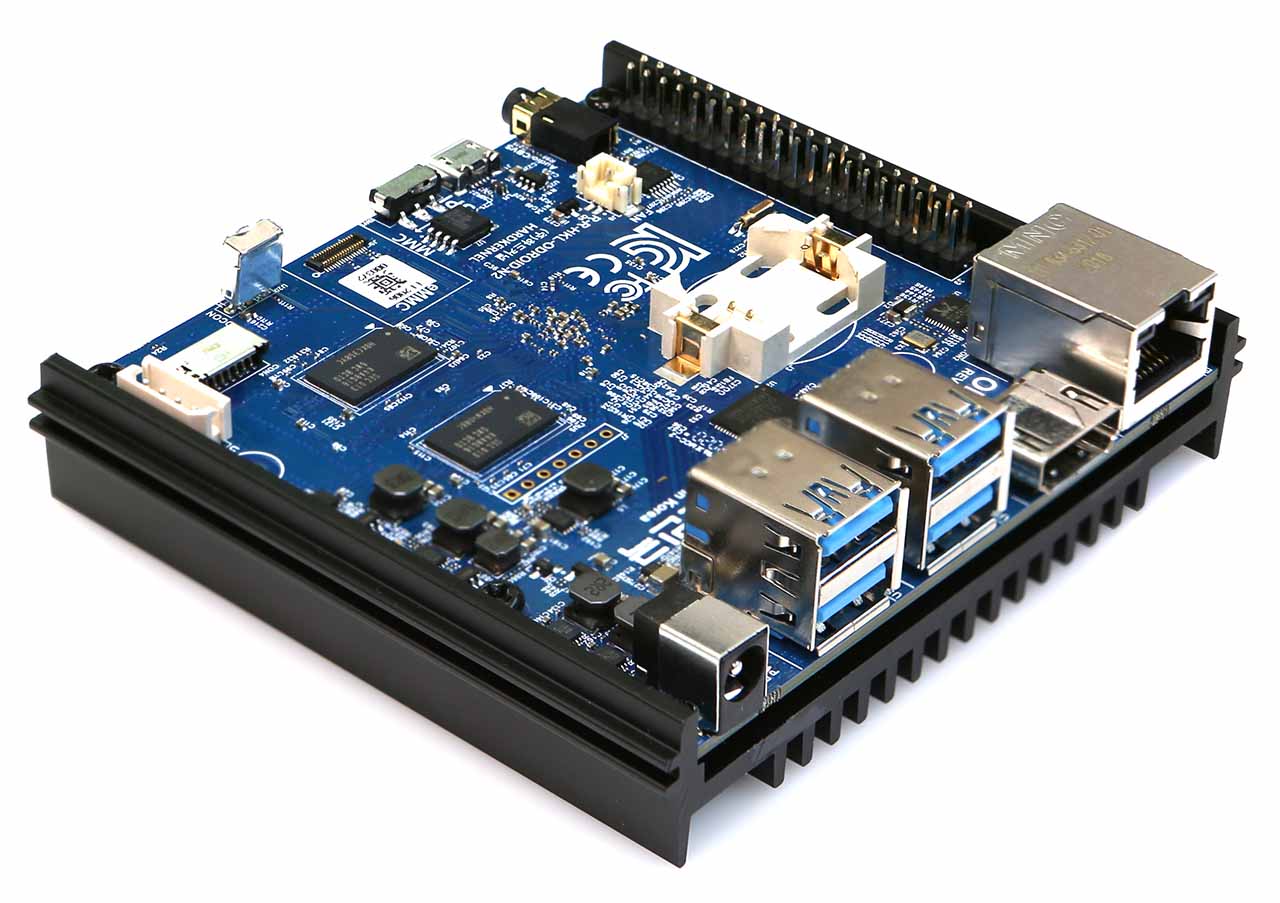
ODROID-N2+ is a revision from ODROID-N2.
– Maximum CPU clock of Quad-core Cortex-A73 is increased to 2.4Ghz from 1.8Ghz.
– Maximum CPU clock of Dual-core Cortex-A53 is increased to 2.0Ghz from 1.9Ghz.
– On-board RTC backup battery holder is mounted on the board.
The main CPU is based on big.Little architecture which integrates a quad-core ARM Cortex-A73 CPU cluster and a dual core Cortex-A53 cluster with a new generation Mali-G52 GPU.
Thanks to the modern 12nm silicon technology, the A73 cores run at 2.2Ghz without thermal throttling using the stock metal-housing heatsink allowing a robust and quiet computer.
The CPU multi-core performance is around 20% faster and the GPU is 10% faster than the N1. The N2+’s DDR4 RAM is running at 1320Mhz with 1.2volt low power consumption.
The large metal housing heatsink is designed to optimize the CPU and RAM heat dissipation and minimize throttling. The CPU is placed on the bottom side of the PCB to establish great thermal characteristics.
More information is on our WiKi.
Board Detail
| A | S922X CPU | J | 1 x SPI Flash 8MiB |
| B | 4 x DDR4 RAM | K | 1 x SPI Boot Select Switch |
| C | 1 x RJ45 Ethernet Port (10/100/1000) | L | 1 x eMMC Module Socket |
| D | 1 x HDMI 2.0 | M | 1 x Micro SD Slot |
| E | 4 x USB 3.0 | N | 1 x IR Receiver |
| F | 2 x System LED Indicators | O | 1 x RTC Backup Battery Holder |
| G | 1 x DC Power Jack | P | 1 x Active Cooling Fan Connector (2-pin) |
| H | 1 x AV Out (Stereo Audio with Composite video) | Q | 40 x GPIO Pins |
| I | 1 x Micro USB2.0 OTG | R | 1 x UART for System Console |
Heatsink size comparison : The system height decreased from 34mm to 29mm approximately thanks to the slimmer heatsink.
N2 block diagram

CPU performance
Dhrystone-2, Double-Precision Whetstone, Sysbench and Memory bandwidth benchmark results show the N2+ system performance comes out ahead of other popular ARM SBCs.
GPU shader performance
The Mali-G52 runs at 800Mhz and is ~10% faster than Mali-T860MP4 in ODROID-N1.
The Mali-G52 is the second Bifrost-based mainstream GPU from Arm.
There are two Shader Processors in the GPU and each core has three Execution Engines. This is sometimes referred to as MP6.
GPU performance was measured with glmark2-es2 “–off-screen” option.

GPU OpenCL performance
Source : Tested by forum user hominoid
The GPU powered hash computing rate on N2 is over 30% faster than N1.
All three SBC ran Lyra2rev2 simultaneously on a shared network. Each platform’s sgminer was compiled with the latest ARM Compute Library v18.11.

Thermal characteristics
To check the thermal throttling, we ran some heavy CPU and GPU loads together on the SoC and monitored temperature. We ran the test within a chamber that keeps the ambient temperature at 35°C. So we believe the large stock passive heatsink is enough for very heavy computing loads.
cmd : stress-ng –cpu 6 –cpu-method matrixprod && glmark2-es2-fbdev –off-screen –run-forever
But you will meet a throttling phenomenon if you overclock the CPU frequency to 2.4Ghz and there is no cooling fan when your room temperature is higher than 30°C.
Gbit Ethernet
According to our iperf test result, the throughput performance was near 1Gbps.

USB 3.0 hosts
We measured the USB transfer speed with a UAS capable SSD.
The average ~340MB/s of throughput should be acceptable for many application.
Since four USB host ports share a single root hub, the transfer rate must be lower if you use multiple USB devices at the same time.


eMMC storage performance
Sequential read and write speed is over 150MB/s and 125MB/s respectively.
4K random access performance is reasonably fast too. iozone test result are as follows.

Micro-SD UHS performance
Using properly implemented UHS dynamic voltage scaling, the sequential read and write speed is over 70MB/s and 55MB/s respectively.

The previous S905 SoC couldn’t activate the UHS mode once the system boots from eMMC. But S922X can keep using the UHS mode with the eMMC module simultaneously.
Sound DAC
ODROID-N2 has an on-board high quality 384Khz/32bit stereo audio line output.
Dynamic range and SNR is near 100dB and Total-Harmonic-Distortion is lower than 0.006%. You can enjoy Hi-Fi sound quality without an external expensive audio DAC.
Signal to Noise Ratio : 1KHz (384KHz, 32bit, 2-ch)

THD + N Ratio : 1KHz (384KHz, 32bit, 2-ch)

Frequency Response : 20Hz – 20KHz(384KHz, 32bit, 2-ch)

SPI Flash memory boot
ODROID-N2 can boot from on-board SPI memory instead of uSD memory or eMMC cards.
The on-board SPI memory is 8MB in size and can include the bootstrap binaries, U-boot, bare minimum Linux kernel, and a ramdisk that includes “Petitboot”. The “Petitboot” software provides a user friendly interface and allows users to select a boot media.
RTC
ODROID-N2 has an on-board RTC component, NXP PCF8563, interfaced to the I2C bus and can use a backup battery as an alternative power source while the main power source is absent. Since the actually measured power consumption is less than 1uA, the RTC can run for over 10 years with a CR2032 backup battery. Also, this will let your ODROID-N2 wake up at a certain time once you set an alarm time and shutdown it.
– Installing RTC backup battery : https://wiki.odroid.com/odroid-n2/getting_started/equip_an_rtc_battery
Crypto Engine
The ARMv8 architecture supports hardware accelerated crypto extensions for building a secure system. As expected, we could see very decent openSSL performance with ODROID-N2.
cmd: openssl speed sha256 (8KByte)

GPIO (40Pin header)

The N2 GPIO interface is similar to C2 and fully supports a 3.3Volt interface while N1 could only support 2.8Volt IO. This is beneficial for using various peripherals without complicated level shifters.
Another big improvement is a faster SPI bus interface. Its maximum frequency is over 150Mhz, and we will try to implement a DMA driven SPI driver for faster LCD display.
Power consumption
Idle state: 1.6~1.8 Watt
Heavy load state: 5.9~6.2 Watt (stress-ng –cpu 6 –cpu-method matrixprod)
No cables are attached except DC power input and USB-UART debug console cable.
Software support
Linux
Ubuntu 20.04 LTS images are available with Kernel version 4.9.230 LTS as of today. This LTS kernel version will be officially supported until Jan, 2023.
The Mali G52 GPU Linux driver works only on the framebuffer and Wayland. We tested the latest PPSSPP emulation and it can handle x3 scaling on a 4K display nicely with well implemented VSYNC.
The fb-dev Mali driver supports OpenGL-ES 1.1, 2.0, 3.0 and 3.1 as well as OpenCL-1.2 and 2.0 at this moment. Note that you have to use the Minimal Ubuntu OS image to utilize the GPU acceleration instead of the Ubuntu Mate image.
There is a Linux Wayland driver too. Ubuntu 20.04 Gnome desktop works with fully accelerated hardware GPU on a modern Kernel 5.11+.
This trial upstream OS image is available on the forum.
Android
Android 9 Pie is ready, and you can access a source code BSP and pre-built image together. Note that GUI layer(SurfaceFlinger) resolution is limited at 2K while the video layer is true 4K.
The Android platform is based on a full 64bit system software with a Vulkan capable GPU driver.
SBC Specification
| Form Factor | Board Dimensions: 90mm x 90mm x 17mmHeatsink Dimensions: 100mm x 91mm x 18.75mm
Weight: 200g including heatsink |
||
| Processor | Amlogic S922X Processor (12nm fab)Quad-core Cortex-A73(up to 2.4Ghz) and Dual-core Cortex-A53 (up to 2Ghz)
ARMv8-A architecture with Neon and Crypto extensions Mali-G52 GPU with 6 x Execution Engines (800Mhz) |
||
| Memory | DDR4 4GiB or 2GiB with 32-bit bus widthData rate: 2640 MT/s (PC4-21333 grade)
1.2Volt low power design |
||
| Storage | 1 x eMMC connector (8G, 16G, 32G, 64G and 128G are available)1 x microSD slot (DS/HS modes up to UHS-I SDR104) | ||
| Networking | 1 x GbE LAN ports (RJ45, supports 10/100/1000 Mbps)– Realtek RTL8211F (Ethernet transceiver)
– LED indicators * Green LED: Flashing by data traffics at 100Mbps connection * Amber LED: Flashing by data traffics at 1000Mbps connection Optional WiFi USB adapters |
||
| Video | 1 x HDMI 2.0 (up to 4K@60Hz with HDR, CEC, EDID)1 x Composite video (3.5mm jack) | ||
| Audio | 1 x Stereo Audio line-out (3.5mm jack)1 x HDMI digital output
1 x Optional SPDIF optical output |
||
| External I/O | 4 x USB 3.0 Host ports (shares one single root hub)1 x USB 2.0 OTG port for Host or Device mode. (No power input)
1 x Debug serial console (UART) 1 x Peripheral Expansion Header (40-pin, 2.54mm pitch) – 2 x DC 5V, 2 x DC 3.3V, 1 x DC 1.8V, 8 x GND – 1 x SPI – 1 x UART – 2 x I2C – 25 x GPIO (Max) – 2 x ADC input (10bit, 1.8V Max) – All 3.3V I/O signal level except for ADC input at max 1.8Volt. |
||
| Other features | On board RTC(Real Time Clock) IC to keep date and time. A CR2032 coin battery holder was replaced with the 2-pin 1.25mm pitch connector.No battery is included in the board.
Please purchase the very common bare CR2032 cell from your local store. You can keep the RTC time up to several years with a 200mAh CR2032 battery. 8MiB SPI Flash for boot manager IR receiver for remote controller Built with a large passive heatsink System LEDS Indicators: – Red (PWR) – Solid light when DC power is connected – Blue (ALIVE) – Flashing like heartbeat while Kernel is running. Active Cooling Fan Connector (5V 2-pin) – Connector (2-pin, 1.25mm pitch) |
||
| Power | 1 x DC jack : outer (negative) diameter 5.5mm, inner(positive) diameter 2.1mmDC 7.5V ~ 18V (up to 25W) *** 7.5V ~ 16V from 2022 production (LOT number starts with EL22)
– DC 12V/2A power adaptor is recommended Power consumption: – IDLE : ≃ 2.2W (Performance governor) – CPU Stress : ≃ 5.9W (@2016/2208MHz), 6.2W (@2016/2400MHz) – Power-off : ≃ 0.2W |
||

